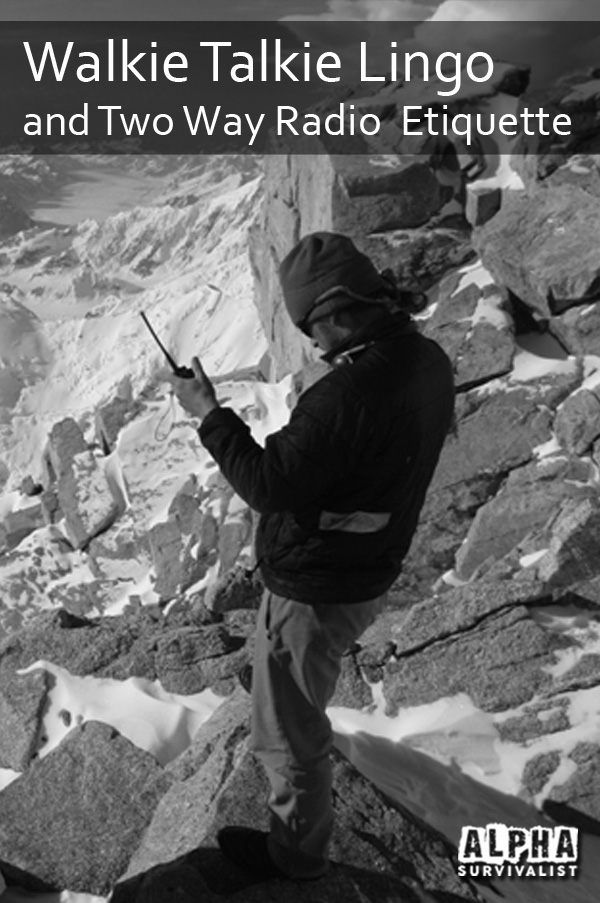In a situation where you are lost, surviving, or even in a doomsday scenario, typical communication channels may not be able to help you. A walkie talkie or a two way radio is going to be your best bet at communicating.
However, simply picking one up and speaking into it is not enough. Knowing the proper walkie talkie lingo is an essential skill to have. Depending on your scenario, the difference between knowing how to speak properly and not could be the difference between life and death.
Basic Communication
There are a few essentials for walkie talkie communication that everybody should know. Knowing these will help you enough to get by.
- “Breaker 1-9” states that you are going to start a transmission.
- “Over” is what’s used to end a transmission.
- “Over and Out” also ends a transmission, but it signifies the end of the conversation as well.
- “Roger” is a term that means “Understood.”
- “10-4” is similar to “Roger” as in it means “Okay/Yes.”
- “Affirmative/Negative” is used instead of “Yes/No.”
- “10-20” or sometimes just “20” depending on the context deals with location. For example, saying “What’s your 20?” asks for a location.
- “Do you copy?” is what you say instead of “Can you hear me?”
10 Codes
In addition to the basic communication techniques, there are also a number of “10 codes.” These are the most complex form of walkie talkie lingo and two way radio communication as there are 101 different codes numbered from 10-1 to 10-100 with an addition code 10-200.
The 10 codes cover basically every situation and by knowing them you’ll be able to navigate survival scenarios with ease.
The different 10 codes are:
- 10-1 – Receiving poorly
- 10-2 – Receiving well
- 10-3 – Stop transmitting
- 10-4 – Message received
- 10-5 – Relay message
- 10-6 – Busy, please stand by
- 10-7 – Out of service, leaving the air
- 10-8 – In service, subject to call
- 10-9 – Repeat message
- 10-10 – Transmission completed, standing by
- 10-11 – Talking too rapidly
- 10-12 – Visitors present
- 10-13 – Advise Weather/Road conditions
- 10-16 – Make pick up at (location)
- 10-17 – Urgent business
- 10-18 – Anything for us?
- 10-19 – Nothing for you, return to base
- 10-20 – My location is (location)
- 10-21 – Call by telephone
- 10-22 – Report in person to
- 10-23 – Stand by
- 10-24 – Completed last assignment
- 10-25 – Can you contact…
- 10-26 – Disregard last information
- 10-27 – I am moving to channel (channel name)
- 10-28 – Identify your station
- 10-29 – Time is up for contact
- 10-30 – Does not conform to FCC rules
- 10-32 – I will give you a radio check
- 10-33 – Emergency Traffic at this station
- 10-34 – Trouble at this station
- 10-35 – Confidential information
- 10-36 – Correct time is (time)
- 10-37 – Wrecker needed at (location)
- 10-38 – Ambulance needed at (location)
- 10-39 – Your message delivered
- 10-41 – Please turn to channel (channel name)
- 10-42 – Traffic accident at (location)
- 10-43 – Traffic tie up at (location)
- 10-44 – I have a message for you
- 10-45 – All units within range please report
- 10-50 – Break channel
- 10-60 – What is next message number?
- 10-62 – Unable to copy, use phone
- 10-63 – Net directed to
- 10-64 – Net clear
- 10-65 – Awaiting your next message/assignment
- 10-67 – All units comply
- 10-70 – Fire at (location)
- 10-71 – Proceed with transmission in sequence
- 10-73 – Speed Trap at (location)
- 10-75 – You are causing interference
- 10-77 – Negative contact
- 10-84 – My telephone number is (number)
- 10-85 – My address is (address)
- 10-91 – Talk closer to the microphone
- 10-92 – Your transmitter is out of adjustment
- 10-93 – Check my frequency on this channel
- 10-94 – Please give me a long count
- 10-95 – Transmit dead carrier for 5 sec
- 10-99 – Mission completed, all units secure
- 10-100 – Need to go to bathroom
- 10-200 – Police needed at (location)

Radio Etiquette for Two Way Radio Users
As with most things in life, the use of two way radio communication is made a lot easier by following certain simple and effective rules, or radio etiquette if you like.
- The internationally accepted language for use on the radio is English, although there are always exceptions which when they are permitted will usually require a license.
- It may seem obvious but unlike a telephone you are unable to speak and listen at the same time when using a two way radio (perhaps I should get my wife and my mother-in-law a radio each!)
- You should never interrupt when you hear others having a conversation on the same channel, you should always wait till they’re done before doing so. However should it be an emergency wait until you hear someone say ‘over‘ and then press PTT and say “BREAK, BREAK, BREAK“, then your call sign, “I have a emergency message for (recipients name or call sign), do you copy, over“.
- Never answer if the call isn’t for you, if you are not sure you should wait until you hear your call sign before responding.
- Never under any circumstances talk about any confidential, sensitive, financial, or share military information whilst transmitting on a radio unless you are 100% sure the channel is encrypted and secure.
Always Remember the Four Rules of Radio Communication
- Clarity: Speak clearly in your normal tone, slow down a little, and never shout.
- Simplicity: Never try to be clever and make your message so complicated others don’t know what you mean.
- Brevity: Don’t beat around the bush, be concise and to the point.
- Security: As mentioned already, never transmit anything that you don’t want others to know. The frequencies you will be using are shared and anybody could be listening in to your frequency intentionally or otherwise.
Finally, you should always think before you speak and never waste your batteries by chatting unnecessarily you never know when you might need them!


